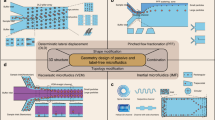Abstract
Laser ablation of glass allows for production of microfluidic devices without the need for hydrofluoric acid and photolithography. The goal of this study was to compare the separation performance of microfluidic devices produced using a low-cost laser ablation system and conventional wet etching. During laser ablation, cracking of the glass substrate was prevented by heating the glass to 300 °C. A range of laser energy densities was found to produce channel depths ranging from 4 to 35 μm and channel widths from 118 to 162 μm. The electroosmotic flow velocity was lower in laser-ablated devices, 0.110 ± 0.005 cm s−1, as compared to wet-etched microfluidic chips, 0.126 ± 0.003 cm s−1. Separations of both small and large molecules performed on both wet- and laser-ablated devices were compared by examining limits of detection, theoretical plate count, and peak asymmetry. Laser-induced fluorescence detection limits were 10 pM fluorescein for both types of devices. Laser-ablated and wet-etched microfluidic chips had reproducible migration times with ≤ 2.8% relative standard deviation and peak asymmetries ranged from 1.0 to 1.8. Numbers of theoretical plates were between 2.8- and 6.2-fold higher on the wet-etched devices compared to laser-ablated devices. Nevertheless, resolution between small and large analytes was accomplished, which indicates that laser ablation may find an application in pedagogical studies of electrophoresis or microfluidic devices, or in settings where hydrofluoric acid cannot be used.




Similar content being viewed by others
References
Sanders GHW, Manz A (2000) TRAC-Trend Anal Chem 19:364–378
Gao J, Xu JD, Locascio LE, Lee CS (2001) Anal Chem 73:2648–2655
Luk VN, Wheeler AR (2009) Anal Chem 81:4524–4530
Foquet M, Korlach J, Zipfel W, Webb WW, Craighead HG (2002) Anal Chem 74:1415–1422
Kopp MU, de Mello AJ, Manz A (1998) Science 280:1046–1048
Hua ZS, Rouse JL, Eckhardt AE, Srinivasan V, Pamula VK, Schell WA, Benton JL, Mitchell TG, Pollack MG (2010) Anal Chem 82:2310–2316
Meloon B, Gamliel N, Sevignani C, Ferracin M, Dumitru CD, Shimizu M, Zupo S, Dono M, Alder H, Bullrich F, Negrini M, Croce CM (2004) Proc Natl Acad Sci U S A 101:9740–9744
Marcus JS, Anderson WF, Quake SR (2006) Anal Chem 78:956–958
Okagbare PI, Soper SA (2009) Analyst 134:97–106
Duffy DC, McDonald C, Schueller OJA, Whitesides GM (1998) Anal Chem 70:4974–4984
Chen D, Du WB, Liu Y, Liu WS, Kuznetsov A, Mendez FE, Philipson LH, Ismagilov RF (2008) Proc Natl Acad Sci U S A 105:16843–16848
Quake SR, Sherer A (2000) Science 290:1536–1540
Thorsen T, Maerkl SJ, Quake SR (2002) Science 298:580–584
Lee JN, Park C, Whitesides GM (2003) Anal Chem 75:6544–6554
Roman GT, McDaniel K, Culbertson CT (2006) Analyst 131:194–201
Makamba H, Kim JH, Lim K, Park N, Hahn JH (2003) Electrophoresis 24:3607–3619
Harrison DJ, Fluri K, Seiler K, Fan Z, Effenhauser CS, Manz A (1993) Science 261:895–897
Klank H, Kutter JP, Geschke O (2002) Lab Chip 2:242–246
Pugmire DL, Waddell EA, Tarlov HR, LE MJ L (2002) Anal Chem 74:871–878
Yen MH, Cheng JY, Wei CW, Chuang YC, Young TH (2006) J Micromech Microeng 16:1143–1153
Schaffer CB, Brodeur A, Garcia JF, Mazur E (2001) Opt Lett 26:93–95
Li Y, Itoh K, Watanabe W, Yamada K, Kuroda D, Nishii J, Jiang Y (2001) Opt Lett 26:1912–1914
Sugioka K, Hanada Y, Midorikawa K (2010) Laser Photonics Rev 4:386–400
Baker CA, Roper MG (2010) J Chrom A 1217:4743–4748
Huang XH, Gordon MJ, Zare RN (1988) Anal Chem 60:1837–1838
Hatch A, Kamholz AE, Hawkins KR, Munson MS, Schilling EA, Weigl BH, Yager P (2001) Nat Biotechnol 19:461–465
Breadmore MC, Wolfe KA, Arcibal IG, Leung WK, Dickson D, Giordano BC, Power ME, Ferrance JP, Feldman SH, Norris PM, Landers JP (2003) Anal Chem 75:1880–1886
Song H, Ismagilov RF (2003) J Am Chem Soc 125:14613–14619
Acknowledgments
This work was funded in part by a grant from the National Institutes of Health (R01 DK080714). We would like to thank the faculty and staff of the Florida State University FormLab for their work in administering the laser etching facilities. We would also like to thank Dr. Eric Lochner in the Department of Physics at Florida State University for acquiring the SEM images.
Author information
Authors and Affiliations
Corresponding author
Additional information
Christopher A. Baker and Rayford Bulloch contributed equally to this work.
Published in the special issue Separation Science of Macromolecules with guest editor André Striegel.
Rights and permissions
About this article
Cite this article
Baker, C.A., Bulloch, R. & Roper, M.G. Comparison of separation performance of laser-ablated and wet-etched microfluidic devices. Anal Bioanal Chem 399, 1473–1479 (2011). https://doi.org/10.1007/s00216-010-4144-3
Received:
Revised:
Accepted:
Published:
Issue Date:
DOI: https://doi.org/10.1007/s00216-010-4144-3




